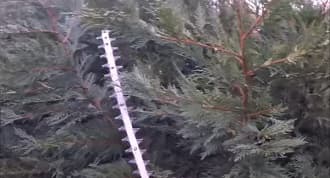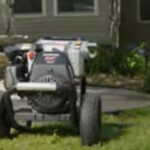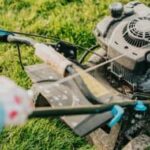As an Amazon Associate, this site earns commissions from qualifying purchases. For more information click here.
If your hedge trimmer is not idling, it is an indication something is wrong with the fuel or engine. Left untreated this can cause long term damage. But this problem can usually be fixed without having to pay for a technician. All you need are a few tools and willingness to tinker with the hedge trimmer. And the process is straightforward.
A wrong fuel mix is the usual reason why hedge trimmers refuse to idle. Drain the tank and pour new fuel. Most hedge trimmers use a 40:1 or 50:1 mixture of gas and oil. Other possible causes are a dirty air filter and low compression.
Let us take a look at the most likely causes in detail and how you can fix them.
Wrong Fuel Mixture
Most hog trimmers are on a 2-stroke engine, which requires a mixture of gas and oil 4 stroke engines have separate reservoirs for oil and gas. But since most trimmers are on a 2-stroke, mixing is required.
If you get the ratio wrong it will cause the hedge trimmer to stop working. In some cases the engine will start and stall. For these reasons you have to make sure that the mix ratio is correct. Fortunately this information is included in your owner’s manual.
Solution. If you think the fuel mixture is wrong, you have to replace the fuel. Turn the trimmer off and empty the tank.
Check your owner’s manual for the proper gas and oil ratio. It will be 50:1 or 40:1. Mix the fuel according to the instructions and fill the tank. Close the lid and turn the hedge trimmer on again. If you got the mixture right it will start idling.
Dirty Air Filter
If you have been using the hedge trimmer to cut pampa grass its air filter will get clogged up with clippings and other debris. Even cutting ordinary grass will at some point clog the filter up. This can cause problems such as the hedge trimmer not idling.
The air filter keeps dirt out of the engine and allows clean air to get through. If the filter is clogged, air will not pass through. Air is necessary to ignite the fuel so this will cause problems.
Solution. Clean or replace the air filter.
Cleaning hedge trimmer air filters is simple enough. Shut the engine off and lift the air filter cover off. Refer to your manual if you are unsure of its location.
Pull the filter out. Most trimmers use a foam filter, which can be reused unlike paper filters. If the dirt is just light, wipe it off with a wire brush. For a very dirty filter, clean it with running water. Or you can dip a piece of cloth in soapy water and wipe the filter.
Put the filter back after it dries. When you turn on the hedge trimmer it should idle. Because air can get into the system, the fuel mixture will be leaner (more air, less fuel).
If this does not affect performance, you can start using it. If the fuel is too lean, you have to adjust the carburetor adjustment screws. This is covered in the next section.
Fresh Fuel Needed
All small engines need fresh fuel to run., and that includes the Poulan Pro. The rule of thumb is to replenish the fuel every 30 days. If you use the hedge trimmer extensively, you might be replacing the fuel more often, which is fine. But you have to discard any gas left over after 30 days.
If you let fuel sit in the reservoir for long periods and the trimmer is not used, it will evaporate. The fuel will leave behind a sticky substance that will clog the carburetor and the rest of the engine. Some hedge trimmers can handle fuel up to 6 weeks old, but others can only use fuel no older than 4 weeks.
Solution. Replace the fuel if it is more than 30 days. Most hedge rimes run on regular unleaded gas at 87 octane. The 87 octane rating is often listed at the minimum requirement for 2-stroke small engines. But some trimmers will only run on 87 octane and nothing else. Switching to a higher rating will not improve performance.

Carburetor Needs Adjustment
Sometimes the carburetor adjustment screws need to be readjusted. If you cleaned the air filter and the fuel gets too lean for instance. Or maybe the fuel mixture is too rich. You can also adjust the screws to fine tune the engine if it does not idle.
Solution. Adjust the carburetor screws.
- You need a screwdriver for this. Turn the hedge trimmer on and allow it to warm up.
- On the carburetor you will see three screws. One is marked L and the other is H. The L is for slow speed and the H is for high speed. You do not have to adjust the third screw.
- Turn the L until the engine is running smoothly without engaging. Make each turn in increments and listen to how the engine responds. Do not make rapid adjustments, Do it slowly.
- Now to the H screw. Run the hedge trimmer at full throttle.
- Rotate the screw counterclockwise until the engine has trouble revving at the highest RPM. Once you reach that point, turn the screw clockwise slowly until goes to maximum RPM again.
Keep in mind that adjusting the carburetor requires a bit of technical knowledge. It is easy enough though, and you just have to make sure the adjustments are made slowly.
Compression is Too Low
Hedge trimmers require a compression level of at least 120 PSI. Anything lower than that and it might cause problems starting the machine. Some trimmers may handle lower compression better though, so check your owner’s manual for information. If you have ruled out the other possibilities and think that compression is too low, you have to test it.
Solution. First you have to check the compression level. If it is too low, find out the reason why and fix it.
How to test a hedge trimmer compression level:
- Get a compression gauge tool. he Betool Compression Tester Kit can get you results quickly so we recommend it.
- Remove the boot on the spark plug. Place a socket wrench on the spark plug and remove it off the cylinder.
- Set the choke to close and move the throttle to wide open.
- Pull the starter cord six times.
- Set the long end of the compression gauge into the cylinder, right where the spark plug was before you pulled it out.
- Keep pulling the start rope until the compression tool is no longer moving. The gauge tool should read at least 120 PSI or whatever the suggested level is by the manufacturer.
If the PSI is lower, there could be an air leak. Inspect the carburetor for any leaks. If there is you have to replace it. If there nothing wrong with the carburetor, the leak may be coming from somewhere else. If all else fails you have to rebuild the engine or replace it.
Blocked Muffler
The exhaust system is essential for any 2-stroke engine. If it gets clogged the hedge trimmer will not be able to run properly. Just like air filters, you have to check this out and consider the possibility that it is the reason why the engine is not idling.
Solution. Clean the exhaust regularly. Every time you do regular maintenance on the trimmer, make it a point to clean the muffler.
The cleaning process may vary depending on the hedge trimmer.
- With a Husqvarna 223L, first you let go of the throttle trigger.
- At the front of the shaft is a switch. Set it to stop.
- Remove the spark plug boot and the spark plug.
- Remove the engine cover.
- Take out the muffler cover and wipe it clean with a wire brush.
Put everything back in place after you are done clearing. Make sure you also clean the engine cover and the spark arrestor along with the muffler. Once you are done, turn the hedge trimmer on and see if it works. This should fix any problems with idling.

I love the outdoors and all the tools for maintaining gardens, yards and lawns. The only thing I am more passionate about is sharing what I know about garden and outdoor equipment.


